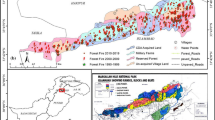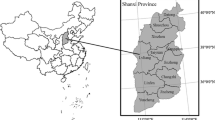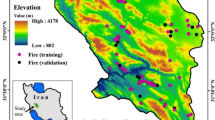Abstract
Forest fires are natural disasters that can occur suddenly and can be very damaging, burning thousands of square kilometers. Prevention is better than suppression and prediction models of forest fire occurrence have developed from the logistic regression model, the geographical weighted logistic regression model, the Lasso regression model, the random forest model, and the support vector machine model based on historical forest fire data from 2000 to 2019 in Jilin Province. The models, along with a distribution map are presented in this paper to provide a theoretical basis for forest fire management in this area. Existing studies show that the prediction accuracies of the two machine learning models are higher than those of the three generalized linear regression models. The accuracies of the random forest model, the support vector machine model, geographical weighted logistic regression model, the Lasso regression model, and logistic model were 88.7%, 87.7%, 86.0%, 85.0% and 84.6%, respectively. Weather is the main factor affecting forest fires, while the impacts of topography factors, human and social-economic factors on fire occurrence were similar.






Similar content being viewed by others
References
Andrews PL (2014) Current status and future needs of the behaveplus fire modeling system. Int J Wildland Fire 23(1):21–33
Andrews PL (2018) The Rothermel surface fire spread model and associated developments: a comprehensive explanation. Gen Tech Rep 121:371
Andrews PL, Loftsgaarden DO, Bradshaw LS (2003) Evaluation of fire danger rating indexes using logistic regression and percentile analysis. Int J Wildland Fire 12(2):213–226
Bisquert M, Caselles E, Sánchez JM, Caselles V (2012) Application of artificial neural networks and logistic regression to the prediction of forest fire danger in Galicia using MODIS data. Int J Wildland Fire 21(8):1025–1029
Boubeta M, Lombardía MJ, Marey-Pérez M, Morales D (2019) Poisson mixed models for predicting number of fires. Int J Wildland Fire 28(3):237–253
Breiman L (2001) Random forests. Mach Learn 45:5–32
Cardille JA, Ventura SJ, Turner MG (2001) Environmental and social factors influencing wildfires in the Upper Midwest. United States Ecol Appl 11(1):111–127
Catry FX, Rego FC, Bação FL, Moreira F (2009) Modeling and mapping wildfire ignition risk in Portugal. Int J Wildland Fire 18(8):921–931
Cawson JG, Duff TJ (2019) Forest fuel bed ignitability under marginal fire weather conditions in Eucalyptus forests. Int J Wildland Fire 28(3):198–204
Cortes C, Vapnik V (1995) Support-vector networks. Mach Learn 20:273–297
Coughlan R, Di Giuseppe F, Vitolo C, Barnard C, Lopez P, Drusch M (2021) Using machine learning to predict fire-ignition occurrences from lightning forecasts. Meteorol Appl 28(1):e1973
Díaz-Avalos C, Peterson DL, Alvarado E, Ferguson SA, Besag JE (2001) Space time modelling of lightning-caused ignitions in the Blue Mountains. Oregon Can J Forest Res 31(9):1579–1593
Elia M, D’Este M, Ascoli D, Giannico V, Spano G, Ganga A, Colangelo G, Lafortezza R, Sanesi G (2020) Estimating the probability of wildfire occurrence in Mediterranean landscapes using artificial neural networks. Environ Impact Assess Rev 85:106474
Eslami R, Azarnoush M, Kialashki A, Kazemzadeh F (2021) Gis-based forest fire susceptibility assessment by random forest, artificial neural network and logistic regression methods. J Trop for Sci 33(2):173–184
Finney MA (1998). FARSITE, Fire Area Simulator--model development and evaluation: US Department of Agriculture, Forest Service, Rocky Mountain Research Station.
Ghosh D, Chinnaiyan AM (2005) Classification and selection of biomarkers in genomic data using LASSO. J Biomed Biotechnol 2:147
Gibson RK, Bradstock RA, Penman T, Keith DA, Driscoll DA (2015) Climatic, vegetation and edaphic influences on the probability of fire across mediterranean woodlands of south-eastern Australia. J Biogeogr 42(9):1750–1760
Gigović L, Pourghasemi HR, Drobnjak S, Bai S (2019) Testing a new ensemble model based on SVM and random forest in forest fire susceptibility assessment and its mapping in Serbia’s Tara National park. Forests 10(5):408
Guo F, Su Z, Wang G, Sun L, Lin F, Liu A (2016a) Wildfire ignition in the forests of southeast China: Identifying drivers and spatial distribution to predict wildfire likelihood. Appl Geogr 66:12–21
Guo F, Wang G, Su Z, Liang H, Wang W, Lin F, Liu A (2016b) What drives forest fire in Fujian, China? Evidence from logistic regression and random forests. Int J Wildland Fire 25(5):505–519
Guo F, Su Z, Wang G, Sun L, Tigabu M, Yang X, Hu H (2017) Understanding fire drivers and relative impacts in different Chinese forest ecosystems. Sci Total Environ 605:411–425
Guo E, Zhang J, Wang Y, Alu S, Wang R, Li D, Ha S (2018) Assessing non-linear variation of temperature and precipitation for different growth periods of maize and their impacts on phenology in the Midwest of Jilin Province. China Theor Appl Climtol 132(3):685–699
Hardy CC, Hardy CE (2007) Fire danger rating in the United States of America: an evolution since 1916. Int J Wildland Fire 16(2):217–231
Jolly WM, Cochrane MA, Freeborn PH, Holden ZA, Brown TJ, Williamson GJ, Bowman DM (2015) Climate-induced variations in global wildfire danger from 1979 to 2013. Nat Commun 6(1):1–11
Keeley JE, Syphard AD (2021) Large California wildfires: 2020 fires in historical context. Fire Ecol 17(1):1–11
Kim SJ, Lim CH, Kim GS, Lee J, Geiger T, Rahmati O, Son Y, Lee WK (2019) Multi-temporal analysis of forest fire probability using socio-economic and environmental variables. Remote Sens 11(1):86
Kreye JK, Hiers JK, Varner JM, Hornsby B, Drukker S, O’brien JJ, (2018) Effects of solar heating on the moisture dynamics of forest floor litter in humid environments: composition, structure, and position matter. Can J Forest Res 48(11):1331–1342
Li Y, Wang YF, Sun YJ, Lei YC, Shao WC, Li J (2022) Temporal-spatial characteristics of NPP and its response to climate change of Larix forests in Jilin Province. Acta Ecol Sin 42:947–959
Lu B, Harris P, Charlton M, Brunsdon C (2014) The GWmodel R package: further topics for exploring spatial heterogeneity using geographically weighted models. Geo-Spatial Inf Sci 17(2):85–101
Ma W, Feng Z, Cheng Z, Chen S, Wang F (2020) Identifying forest fire driving factors and related impacts in China using random forest algorithm. Forests 11(5):507
Martínez-Fernández J, Chuvieco E, Koutsias N (2013) Modelling long-term fire occurrence factors in Spain by accounting for local variations with geographically weighted regression. Nat Hazards Earth Sys 13(2):311–327
Milanović S, Marković N, Pamučar D, Gigović L, Kostić P, Milanović SD (2020) Forest fire probability mapping in eastern Serbia: logistic regression versus random forest method. Forests 12(1):5
Miranda-Aragón L, Treviño-Garza E, Jiménez-Pérez J, Aguirre-Calderón O, González-Tagle M, Pompa-García M, Aguirre-Salado C (2012) Modeling susceptibility to deforestation of remaining ecosystems in North Central Mexico with logistic regression. J Forestry Res 23(3):345–354
Mozny M, Trnka M, Brázdil R (2021) Climate change driven changes of vegetation fires in the Czech Republic. Theor Appl Clim 143(1):691–699
Nadeem K, Taylor S, Woolford DG, Dean C (2019) Mesoscale spatiotemporal predictive models of daily human-and lightning-caused wildland fire occurrence in British Columbia. Int J Wildland Fire 29(1):11–27
Nurdiati S, Sopaheluwakan A, Julianto MT, Septiawan P, Rohimahastuti F (2022) Modelling and analysis impact of El Nino and IOD to land and forest fire using polynomial and generalized logistic function: cases study in South Sumatra and Kalimantan. Indonesia Model Earth Syst Environ 8(3):3341–3356
Nyman P, Metzen D, Noske PJ, Lane PN, Sheridan GJ (2015) Quantifying the effects of topographic aspect on water content and temperature in fine surface fuel. Int J Wildland Fire 24(8):1129–1142
Ordóñez C, Saavedra A, Rodríguez-Pérez JR, Castedo-Dorado F, Covián E (2012) Using model-based geostatistics to predict lightning-caused wildfires. Environ Model Softw 29(1):44–50
Peterson D, Wang J, Ichoku C, Remer L (2010) Effects of lightning and other meteorological factors on fire activity in the North American boreal forest: implications for fire weather forecasting. Atmos Chem Phys 10(14):6873–6888
Pham BT, Jaafari A, Avand M, Al-Ansari N, Du Dinh T, Yen HPH, Phong TV, Nguyen DH, Le HV, Mafi-Gholami D (2020) Performance evaluation of machine learning methods for forest fire modeling and prediction. Symmetry 12(6):1022
Phelps N, Woolford DG (2021) Guidelines for effective evaluation and comparison of wildland fire occurrence prediction models. Int J Wildland Fire 30(4):225–240
Ranstam J, Cook J (2018) LASSO regression. Br J Surg 105(10):1348–1348
Rijal B (2018) Quantile regression: an alternative approach to modelling forest area burned by individual fires. Int J Wildland Fire 27(8):538–549
Rodrigues M, de la Riva J, Fotheringham S (2014) Modeling the spatial variation of the explanatory factors of human-caused wildfires in Spain using geographically weighted logistic regression. Appl Geogr 48:52–63
Rodrigues M, Costafreda-Aumedes S, Comas C, Vega-García C (2019) Spatial stratification of wildfire drivers towards enhanced definition of large-fire regime zoning and fire seasons. Sci Total Environ 689:634–644
Rudin C (2019) Stop explaining black box machine learning models for high stakes decisions and use interpretable models instead. Nat Mach Intell 1(5):206–215
Senande-Rivera M, Insua-Costa D, Miguez-Macho G (2022) Spatial and temporal expansion of global wildland fire activity in response to climate change. Nat Commun 13(1):1–9
Sharma LK, Gupta R, Fatima N (2022) Assessing the predictive efficacy of six machine learning algorithms for the susceptibility of Indian forests to fire. Int J Wildland Fire 31(8):735–758
Strobl R, Grill E, Mansmann U (2012) Graphical modeling of binary data using the LASSO: a simulation study. BMC Med Res Method 12(1):1–13
Šturm T, Podobnikar T (2017) A probability model for long-term forest fire occurrence in the Karst forest management area of Slovenia. Int J Wildland Fire 26(5):399–412
Su Z, Zheng L, Luo S, Tigabu M, Guo F (2021) Modeling wildfire drivers in Chinese tropical forest ecosystems using global logistic regression and geographically weighted logistic regression. Nat Hazard 108(1):1317–1345
Taylor SW, Alexander ME (2006) Science, technology, and human factors in fire danger rating: the Canadian experience. Int J Wildland Fire 15(1):121–135
Tibshirani R, Saunders M, Rosset S, Zhu J, Knight K (2005) Sparsity and smoothness via the fused lasso. J R Stat Soc Ser B Stat Methodol 67(1):91–108
van der Velde IR, van der Werf GR, Houweling S, Maasakkers JD, Borsdorff T, Landgraf J, Tol P, van Kempen TA, van Hees R, Hoogeveen R (2021) Vast CO2 release from Australian fires in 2019–2020 constrained by satellite. Nature 597(7876):366–369
Wang Z, Lai C, Chen X, Yang B, Zhao S, Bai X (2015) Flood hazard risk assessment model based on random forest. J Hydrol 527:1130–1141
Yang G, Di XY, Zeng T, Shu Z, Wang C, Yu HZ (2010) Prediction of area burned under climatic change scenarios: a case study in the Great Xing’an Mountains boreal forest. J Forestry Res 21(2):213–218
Zhu Y, Yu Q, Luo Q, Zhang H, Zhao J, Ju Z, Du Y, Yang Y (2021) Impacts of climate change on suitability zonation for potato cultivation in Jilin Province. Northeast China Sci Rep 11(1):1–14
Author information
Authors and Affiliations
Corresponding author
Additional information
Publisher's Note
Springer Nature remains neutral with regard to jurisdictional claims in published maps and institutional affiliations.
Project Funding: This research was funded by the National Natural Science Foundation of China (grant no. 32271881).
The online version is available at http://www.springerlink.com
Corresponding editor: Yu Lei.
Rights and permissions
Springer Nature or its licensor (e.g. a society or other partner) holds exclusive rights to this article under a publishing agreement with the author(s) or other rightsholder(s); author self-archiving of the accepted manuscript version of this article is solely governed by the terms of such publishing agreement and applicable law.
About this article
Cite this article
Gao, B., Shan, Y., Liu, X. et al. Prediction and driving factors of forest fire occurrence in Jilin Province, China. J. For. Res. 35, 21 (2024). https://doi.org/10.1007/s11676-023-01663-w
Received:
Accepted:
Published:
DOI: https://doi.org/10.1007/s11676-023-01663-w




